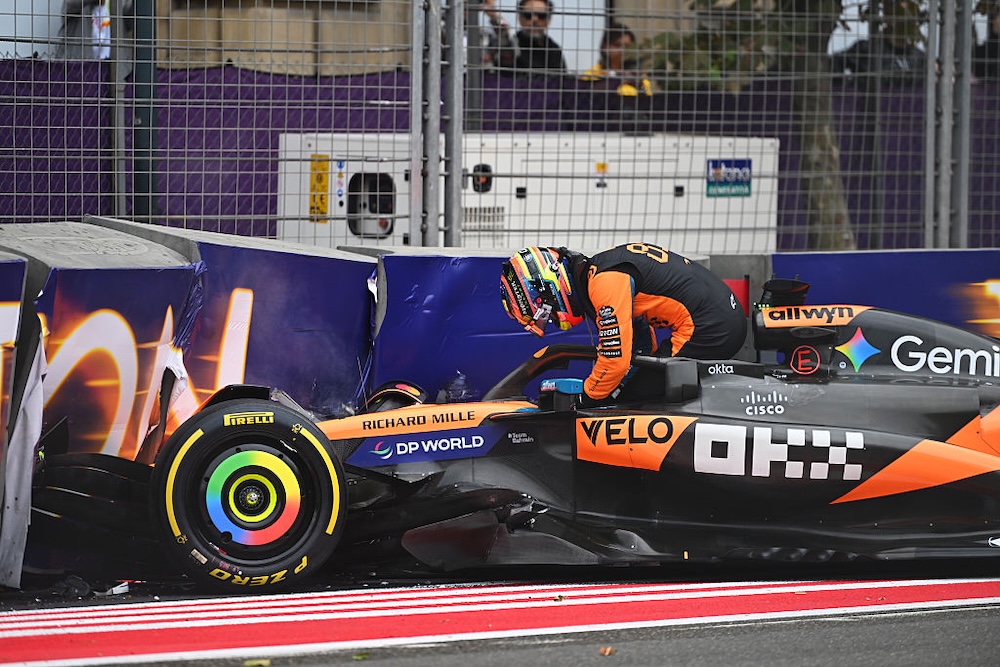Oscar Piastri had the world championship in his grasp and has cracked under pressure, falling apart at the business end of the season and showing the mental frailty underneath the superficial ice-cool façade.
That’s a narrative that’s built momentum lately, but one that’s as shallow and unsatisfactory as the alternative commentary that portrays Piastri as a passenger who has had the legs cut out from under him by McLaren’s favoritism helping teammate Lando Norris. F1 is complex, the intertwining of the human and the technological making it endlessly fascinating, and the real story of Piastri’s season can’t be so easily simplified. It also means that, despite being 24 points behind with three events left, he’s no busted flush.
But Piastri must reverse his fortunes fast. Heading into the title-deciding triple-header across Las Vegas, Qatar and Abu Dhabi, he’s on a run of six consecutive events where he’s lost points to Norris. That’s resulted in a swing of 59 points against him and in favor of Norris, which is clear evidence of a championship being lost by Piastri even if the reasons for his slump are up for debate. And to unravel what’s really happened, you cannot attribute those difficulties and the resulting points losses a single fundamental cause. Just as piecing together a good race weekend and stringing those together to make a strong season, is always about the details, so too is building a real understanding of what’s gone wrong.
Inevitably, what happened at Monza looms large in the story of Piastri’s season. There, he lost out in qualifying but his underlying pace had been good enough to have had a shot at beating Norris only to be too conservative into the first corner on his final Q3 lap. He wasn’t a threat to Norris on track in the race, but infamously had to cede second place to his teammate after McLaren inverted the pitstop order.
This not only gave Piastri the undercut – according to McLaren, because of the vague threat of Charles Leclerc undercutting him had Norris been the first McLaren driver to stop – but also led to Norris losing time to a fumbled pitstop. Despite Piastri arguing over the radio that a slow pitstop had been agreed to be “part of racing”, McLaren’s argument was that this wasn’t a mistake offering a legitimate gain, but only happened because Norris ceded his right to pit first to help Piastri and the team overall.
While criticized by some as evidence Norris was favored, this actually reflected McLaren’s laudable but misguided and over-engineered philosophy of trying to ensure racing fairness between its two drivers. Piastri said after the race that “the context wasn’t there” when he railed against the order during the race, appearing to accept it, but it’s clear it didn’t sit well with him. Speaking on a recent edition of F1’s Beyond the Grid Podcast, he admitted the irritation at that carried over into the disastrous Azerbaijan Grand Prix weekend, where he crashed both in qualifying and on the first lap of the race.
“Obviously the race before that was Monza, which I didn’t feel was a particularly great weekend from my own performance, and there was obviously what happened with the pitstops,” said Piastri. “But then also Baku itself: Friday was tough, things weren’t working, I was overdriving. I wasn’t very happy with how I was driving, and ultimately probably trying to make up for that a little bit on Saturday.
“There were some things in the lead-up that were maybe not the most helpful, and then things that happened on the weekend – we had an engine problem in FP1 that unsettled things a bit, then I was driving not that well, we were on C6 tires that weekend that are now notoriously tricky to handle. There were just a lot of little things that kind of added up. I felt like on Saturday my pace was good but I was just trying a little too hard. That was the worst weekend I’ve ever had in racing, but probably the most useful in some ways.”
Speaking in Brazil about what happened at Baku, he again put it down to a combination of “trying a bit too hard” and, in an oblique nod to Monza, mentioned “there were some other things that maybe crept in”. And while that can partly be put down to McLaren’s overly-meddlesome attempts to ensure racing fairness between the two while protecting the interests of the team in terms of maximizing results, it’s also an admission by Piastri that he couldn’t shut out what happened at Monza. It’s understandable – considering what’s at stake, it’s not difficult to put yourself in his position and have the same concerns – but it’s also a necessity to be able to shut such things out when
